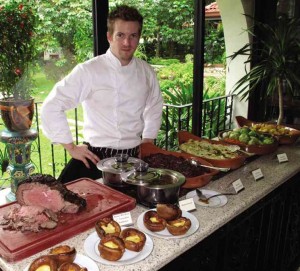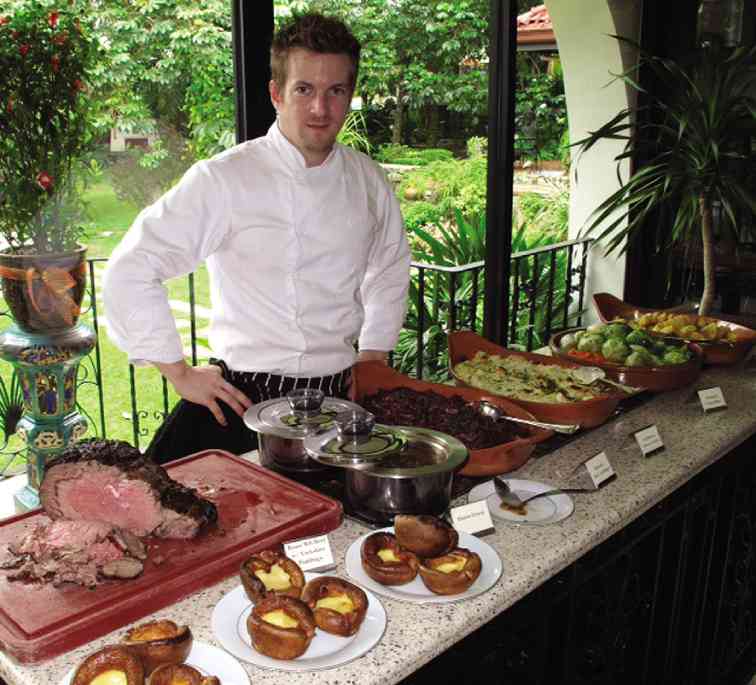
When my son Diego received his First Communion, the milestone called for a celebration. I thought, what better way than to feast on something traditional—a classic English roast with all its fixings prepared by British chef Matthew J Hornsby-Bates.
Our menu: Broccoli and Blue Cheese Soup; Roast Rib of Beef with Yorkshire Puddings; Goose Fat Roast Potatoes; Cauliflower Cheese Gratin; Selected Seasonal Vegetables; Braised Red Cabbage; Lashings of Onion Gravy Horseradish Sauce; and Apple Crumble with Custard.
Bates believes the English roast is a culture by itself, a meal compared to Christmas, “a less grand version than a holiday meal, but no less wonderful.”
The British Sunday Dinner, or Sunday Roast as it was called, is the main meal of the week, says Bates.
Roast beef has long been part of British culinary tradition. According to him, in the 18th century, it was praised as an “Englishman’s food,” which “ennobled our brains and enriched our blood.” Served in the early afternoon, a roast is typically served with Yorkshire pudding and all its glorious fixings like gravy, cauliflower cheese, vegetable dishes and roast potatoes.
“The Sunday lunch probably originates from the hearty meal of meat and potatoes, which landowners would reward their laborers with on a Sunday after church,” says Bates. “When families started cooking their own Sunday lunches, they would often use the remains as a basis for meals for the next week.”
Filler
Yorkshire pudding was originally used as a first-course filler for people who could not afford much meat.
“Years ago,” says Bates, “when the meat was cooked on a spit or trivet, the batter was put underneath and the fat and meat juice dripped onto the batter. If there wasn’t enough meat to go around, the children would get Yorkshire pudding and gravy as their main meal. Now the dish is almost always served with a roast beef main course to form part of a ‘traditional English dinner.’”
In England, roast beef is often served on its own, filled with onion gravy so that it acts as a form of edible soup bowl.
“It has become very popular with tourists in search of traditional English fare and ranks along with fish and chips as an internationally known item of English cuisine. Many foreigners believe the English national dish is Roast Beef with Yorkshire Pudding, but as we all know, it is really curry.
“Being British, I must say that there is nothing I love more than a traditional roast dinner. It’s a meal we are all raised on in England and one that will never be forgotten,” says Bates.
Variations
As a chef, Bates has worked in many restaurants around England, and the traditional roast is a dish he has cooked time and time again. He has made many variations.
“My favorite meat cut, the fore rib of beef, has plenty of fat marbled through the flesh that adds flavor and keeps the meat tender during cooking,” he explains. “Other variations include pork, lamb and game. Whatever your choice of meat, a selection of sides must go with it.”
He emphasizes the importance of gravy. “Gravy is the sauce made from meat juices and the essential way to complete your roast. In my opinion, the gravy should be lashed on your plate as if it was going out of fashion.”
Other accompaniments may be horseradish sauce, mint sauce and apple sauce.
Roast Beef with Yorkshire Puddings
- x 4.5-kg rib of beef
- tbsp goose fat
- Salt and black pepper
- A splash of dark soy sauce
For the Yorkshire puddings:
- 300 ml milk
- 4 large eggs
- 250 g plain flour
- A splash of soda water or lemonade
For the gravy:
- 4 white onions, sliced
- 50 g brown sugar
- A splash of balsamic vinegar
- 2 tbsp plain flour
- ½ bottle red wine
- 200 ml beef stock
For the beef:
- Preheat the oven to 220 °C.
- Rub the beef with a little goose fat and a splash of soy sauce, and season with salt and pepper. (Soy sauce will not only give great color but will also caramelize as the meat cooks, giving it a crisp, sweet finish.)
- Place a heavy-based roasting tray on the hob and, when hot, add the beef, which should sear quickly on all sides to get beautiful color and lock in the juices.
- Transfer to the oven and cook for around 50 minutes to get the meat nice and rare.
- Remove from the oven and place on a tray for resting.
- Loosely cover with foil and rest the meat for a minimum of 40 minutes before carving, allowing the juices to seep back into the flesh.
- Retain any leftover meat juice for the gravy.
For the Yorkshire puddings:
- Whisk together the milk and eggs, then slowly whisk in the flour to form a smooth batter. Add a pinch of salt and pepper. A little secret is to add a splash of soda water or lemonade.
- Place in a jug and let stand for a minimum of two hours.
- When you’re ready to cook the Yorkshire pudding, heavily grease the muffin tray or pudding tray with goose fat and place in a hot oven for five minuets or until it starts to smoke.
- Remove from the oven and pour the batter around half of the way up and return to the oven for a further 25-30 minutes.
- Make sure not to open the oven door beforehand as your pudding will sink.
For the gravy:
- Tip off the excess fat from the pan where the beef was cooked. Scatter plain flour into the pan and mix it together to make a roux.
- Add the wine and beef stock. Cook over medium heat, stirring constantly, until thickened. Pass through a sieve.
- Caramelize some finely sliced onion in a pan with some balsamic vinegar and brown sugar; once they are cooked and slightly sticky, add a glass of red wine and reduce for five minutes. Add the beef gravy and reduce further until you have the consistency to coat the back of a spoon.
- Carve the beef and serve with your choice of sides and roasted potatoes.
Call chef Matthew at 0917-5825441, or visit him at The Early Bird Breakfast Club, Unit 2, G/F, Fort Point Pointe 2 Bldg., 28th St., The Fort Complex, Bonifacio Global City.









































